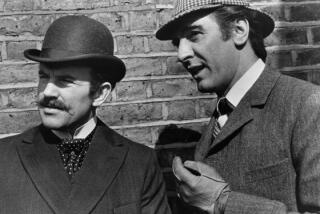Frankly, My Dear, ‘It Has Become of No Concern to Me’
- Share via
NEW YORK — Using a treasure trove of documents few people knew existed, film expert Aljean Harmetz has re-created the making of one of the world’s most successful movies--”Gone With the Wind”--and in the process has uncovered a farcical censorship battle fit for a Marx Brothers film.
Hard as it may be to believe in the 1990s, there was a titanic battle between censors and filmmakers over whether the film could include the word “damn” in the 1939 Civil War epic’s most famous line when Rhett Butler turned on Scarlett O’Hara and told her, “Frankly, my dear, I don’t give a damn.”
Harmetz, author of the just-published “On the Road to Tara, the Making of Gone With the Wind” (Abrams), said the censors would have been happier with “Frankly, my dear, I don’t give a hoot,” a line one of producer David O. Selznick’s many script consultants had suggested.
Other suggestions that would not have made film history were: “It makes my gorge rise,” “It has become of no concern to me” and “My indifference is boundless.”
After many letters and meetings with various censorship bodies that oversaw filmmaking in the 1930s, Selznick went ahead and used the word “damn”--but only after he got assurances that his much-needed production code seal would not be lifted. For his damning offense, he was fined $5,000.
In an era where almost anything goes in filmmaking and hardly a word in the English language has not been used on screen, that battle may sound a bit old-fashioned, but Harmetz says it was just one of several censorship fights discovered when she was given access to Selznick’s personal papers by his son.
It was the first time an outsider had been allowed to see the legendary producer’s private papers and they revealed many details about the making of the film that has become a screen classic and grossed a billion dollars by today’s standards.
*
The censors did not allow Selznick to show the pain of childbirth in one scene because the woman giving birth was happily married, or to suggest that another character from the book was a prostitute. So she became a barkeeper, even though the then-powerful Legion of Decency was not fooled for a second.
“The censors did not allow sex either explicit or illicit, so the famous morning-after scene when Vivien Leigh [who played Scarlett O’Hara] looks much too happy after being raped by Clark Gable [Rhett Butler] was trimmed. But she still looks happy,” Harmetz said.
But she said one battle the censors won was fortunate for everyone connected with the film. The censors, supported by protests from black groups, convinced Selznick not to use an epithet that appeared frequently in Margaret Mitchell’s best-selling book, which came down on the side of the slaveholding South in the Civil War.
Selznick also declined to portray the Ku Klux Klan as heroic, as the book does, or claim that slaves were happy in bondage, as the book also does. But Selznick, whose constant tampering with the script for the film drove a succession of screenwriters up the wall, kept thinking that perhaps he should find a way to use the objectionable N-word--if it could be done tastefully.
In a letter to his script consultant Val Lewton, he said he could not believe he would offend “any Negroes if we use the word with care.” Lewton convinced him otherwise.
Harmetz said Selznick went through 11 screenwriters and script doctors before finally going back to the original script by playwright Sidney Howard. At one point, he ordered a rewrite of a rewrite he had not even read. Some might say it was enough to make a writer’s “gorge rise.”
More to Read
Only good movies
Get the Indie Focus newsletter, Mark Olsen's weekly guide to the world of cinema.
You may occasionally receive promotional content from the Los Angeles Times.










